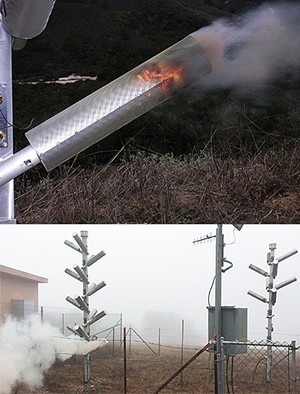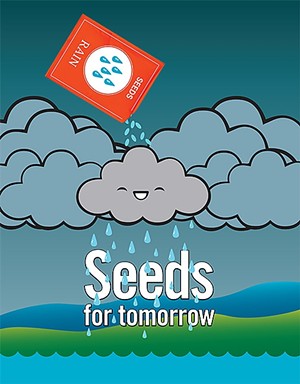The storm is rolling in. It’s January. A parched fall, thus far followed by an abnormally dry winter—which helped produce the largest fire in California’s recorded history—is already giving the state’s farmers and water managers visions of imminent, crippling drought. And while the deluge associated with this particular moisture system rolling in off the Pacific Ocean will ultimately create the deadly Montecito mudflows, to say the rain is overdue is an understatement. Reservoirs need to be filled, groundwater basins require recharging, and miles of farmland are thirsty for liquid relief.
It’s why today a handful of Public Works employees for Santa Barbara County aren’t battening down the hatches in preparation for the destructive storm. No, out here at Twitchell Dam, with a sea of low-hanging gray clouds kissing the Santa Maria Valley floor, the men and women on site are doing what critics describe as anything from a waste of time to “playing God.”
This day is just one of many where Santa Barbara County engineers and contracted scientists attempt to harness the skies as they try to make it rain.
Since 1981, the county’s cloud seeding program has been used as a way to supplement dwindling water supplies in the face of population explosions and rapid urbanization and development, all set amid an uncertain climatic backdrop filled with rising temperatures, prolonged droughts, and higher intensity winter storms.
The program’s proponents point to decades of data, alleging increases in runoff by as much as 20 percent (or 4 to 5 inches of additional rainfall) as a result of the practice. Critics deride it as an imprecise, immeasurable science, limited in scope and accuracy, and some even go as far to label it a waste of time and money.
Despite those objections, the county still reaches for the skies each winter hoping to drain every last drop of water it possibly can.
“It’s been supported by our water [agencies] over the years because it’s a relatively cost-effective, supplemental water supply,” Santa Barbara County Water Agency Manager Fray Crease told the Sun.
How does it work?
To understand how cloud seeding works, one must first have a basic understanding of how rain naturally occurs. Brad Rippey, a USDA meteorologist and one of two authors for the U.S. Drought Monitor, explained that raindrops need a condensation nucleus in order to form.
“In the real world, you’ve got particles of things like dust, smoke, or pollen even,” he told the Sun.

The particles make their way up through the earth’s atmosphere, where they eventually encounter clouds. Water molecules in the clouds then stick to the particles until a maximum weight is reached, finally forming into water droplets, snowflakes, or ice crystals before cascading to the planet’s surface.
“Any impurity, really, can form a condensation nucleus,” Rippey said. Which leads to the theory of cloud seeding, he added. “If you get something that’s really conducive to forming nuclei, you might be able to enhance the developing raindrops.”
That’s where silver iodide comes in. The naturally occuring, yellow-colored simple salt compound was found to be highly adept at producing ice crystals when dropped into sub-freezing water clouds in the 1940s by Dr. Bernard Vonnegut, the older brother to his more famous sibling, Kurt.
Vonnegut made the discovery while working in the General Electric Research Laboratory, along with his colleague Dr. Vincent Schaefer, who was the first scientist to observe artificial snow in a lab setting.
“What Dr. Vonnegut found was that the tiny particles of silver iodide were very effective as an artificial ice nucleant, and they could typically operate at warmer temperatures than their naturally occurring counterparts,” said Don Griffith, a meteorologist with North American Weather Consultants, adding the chemical structure of the compound mimics crystalline ice. Griffith’s firm conducts Santa Barbara County’s cloud seeding operations and will do the same for San Luis Obispo, but only if the county’s supervisors approve a proposed cloud seeding program in June.
Griffith explained that most modern cloud seeding practices involved burning silver iodide from what essentially looks like a roadside flare. The flares are attached to towers, usually on hilltops and mountains above rivers, lakes, and streams (watersheds), and then set to burn by remote timer once conditions are right. Flares can also be attached to aircraft to cover rougher terrain.
Conducive conditions include temperature (the cloud needs to be between 14 degrees and 23 degrees Fahrenheit) and the storm’s makeup, such as how its convective band of moisture is organized. The temperature is important because that sub-freezing range is just about the sweet spot for clouds to retain moisture without crystallizing into ice entirely.
“Mother Nature is pretty inefficient at freezing those cloud droplets that are colder than freezing until you reach about [5 degrees Fahrenheit],” Griffith said. At that low threshold, “nature takes over,” he added, which is why silver iodide is so handy for coaxing more rain out of storms.
As for the convective bands, the U.S. Drought Monitor’s Rippey explained that most moisture systems resemble commas on a radar, with the low pressure system acting as the circle and the band acting as the tailing end of the punctuation symbol. Not only do these pieces of the storms carry the most precipitation, they also come with the most uplift, or winds that would push material or particles from the ground up into the atmosphere.
“Normally, a convective band would be associated with a cold front or some kind of trough, funnel zone; it can be masquerading as a number of different names,” Rippey said.
What’s important to understand is that scientists and county staff aren’t making clouds or rain storms when they attempt to cloud seed—they are augmenting them to increase precipitation.
“I wonder if the term ‘cloud seeding’ is a little bit of a misnomer,” Santa Barbara’s Crease said. “I sometimes think it’s more accurate to say ‘storm seeding,’ at least here. I think people get confused sometimes about what it is that we do and when we do it. Why do we target these sorts of organized convective bands? Because that’s the kind of storm we are looking for. We’re not just going, ‘Oh, is it cloudy?’ because it just doesn’t work that way. The point is to introduce the silver iodide molecules into the storm system so that the rain can actually condense around them, like on a foggy day when rain condenses on your car’s windshield, it’s the same in a cloud in this instance.”
Crease added that oftentimes the public confused contrails from airplanes or rocket launches as examples of cloud seeding.
“That’s probably the biggest misconception,” she said, “someone looks up, sees a jet trail in the sky, and thinks we’re cloud seeding—that’s not the case.
“That’s something completely different.”
Supplemental supply
Since the winter of 2014-15, Santa Barbara County has spent more than $1 million on its cloud seeding program. In that first year, the Cachuma-Santa Ynez and Twitchell watersheds were both targeted for a period of five months (which is the usual timeline for operations) with both ground and air operations. The final cost came out to roughly $330,000. The next two winters, the county spent at least that much, ($404,400 in 2015-16; and $396,875 the following year).
The winter of 2017-18 was the cheapest of the bunch, coming out to just about $156,000, but that is due to two factors: the first being that only the Twitchell Watershed was targeted; and the second being the reason why—the Whittier and Thomas fires from the previous year made running the program in the Cachuma watershed too dangerous for both the water supply and the residents living in those areas. The limited operation area meant the county only needed to use its ground units at Twitchell, so the aircraft was grounded.

According to Crease, the county’s costs include contractor fees and site leases but did not included Water Agency staff time spent administering the program. She said Twitchell and Cachuma were the only two sites targeted for extended cloud seeding during normal years.
The costs, she added, are relatively low considering the dividends that cloud seeding yields. A study completed by Griffith’s North America Weather Consultants in 2013 while contracting for Santa Barbara County found average annual precipitation increases of around 20 percent (the equivalent of 4 additional inches of rain) between 1985 and 2011 for the Santa Ynez Watershed. Twitchell in that same period saw average annual increases of around 17 percent, or 1.9 inches of water.
Crease noted the county would not target the Cachuma-Santa Ynez watershed until the landscape was able to recover from the fires over the next few years. In terms of the mudflows in Montecito, Crease said, “We’ve tried to make it clear this year that we were not at all anywhere near the Santa Ynez Watershed this winter.”
In San Luis Obispo County, the proposed target areas for cloud seeding are in the Lopez and Salinas watersheds. Santa Margarita Lake would also be targeted.
SLO Water Resources Division Technical Supervisor Ray Dienzo told the Sun the program was estimated to cost the county $140,000 annually for ground operations, with an additional $160,000 added to that price tag if aircraft were used. He said the potential precipitation could be on “the low end, at least 3,000 acre feet of water” for Lopez and Santa Margarita lakes.
“If state water is about $1,500 dollars per acre foot, I mean, do the math on that,” Dienzo added. “It’s definitely cheaper than some of other options out there like recycled or desal or anything like that, and it’s something we can do right away.”
Dienzo mentioned the proposed desalination project at the Diablo Canyon nuclear power plant, which is expected to shutter in 2025. The desal plant could convert ocean water to drinking for thousands of coastal residents.
“That’s on the backburner for now,” he said.
Diversified water portfolio
SLO County is interested in cloud seeding for the same reason many California municipalities and agencies have been for years.
“In 2016, in the south part of the county especially, we were really concerned they were going to run out of water,” Dienzo explained.
It’s why the county conducted a feasibility study in 2017 to examine the efficacy of a cloud seeding program and also why SLO County Supervisors will vote on the program on June 19.
“We saw that it could add good water supply to our watersheds,” Dienzo said. “To me, it’s a good option to pursue.”
Coming to terms with shrinking water supplies is a reality that most water agencies in California have understood for more than a century. Look no further than the State Water Project, or its Central Valley counterpart, or the infamous Los Angeles Aqueduct, the last of which’s water wars inspired years of conflict and became the subject for classic films like Chinatown.
However, a relative population boom over the past 60 years in California, coupled with rising temperatures and prolonged dry periods punctuated by intense rainstorms, has pushed the state’s aging water infrastructure to the brink.
For that reason, many politicians are looking at their districts closely to see how best to manage an imminent water crisis.
Congressman Salud Carbajal (D-Santa Barbara), on April 23 announced a bill aimed at establishing a multi-million dollar grant program to build and repair wells, canals, old pipes, and other water infrastructure. The program would last five years and be administered by the U.S. Environmental Protection Agency (EPA). The money is currently proposed to arrive in $50 million annual installments to recipients.
“It’s different than other programs because this one focuses on creating resilient infrastructure and expanding water quality and conservation, including wastewater,” Carbajal explained.
His announcement came the same week a group of UCLA researchers released a new study noting an increase in periods between droughts and wet periods in California. In particular, the study’s authors said that not only would dry years be drier in the coming decades, but that wet periods would be equally intense.
“Such hydrological cycle intensification would seriously challenge California’s existing water storage, conveyance, and flood control infrastructure,” the authors wrote.
The Drought Monitor’s Rippey told the Sun that he had not read the aforementioned study but said he was familiar with similar research in the field. He said it was clear the state was seeing longer dry spells punctuated by extreme precipitation events.
“I think California is kind of the poster child for that the past few years,” he added, “where you’ve gone from historic drought over a four to five year period followed by this incredible wet season that occured in 2016-17—atmospheric river events that dumped incredible amounts of precipitation that were just off the charts really.” Rippey noted states like California and Texas were seeing droughts and rain events that historically occur once every century, but now those extremes are becoming somewhat of a new normal.
“It used to be, ‘Well, we had the ’30s Dust Bowl,’ or, ‘We had the bad drought in the ’50s,’ but now we are having these ups and downs where we go from extreme wetness to incredible dryness just in a period of a few months, so all bets are off on what direction we’re heading at any given time it seems like,” he said.
In that context, Rippey said he understands why local water agency managers would want to look into cloud seeding. He’s just not convinced of its effectiveness.
“That type of manipulation of weather remains very controversial in some circles, but for me, I’m just not sure if we have the precision to make it worthwhile yet,” he added. “Maybe someday somebody will figure out a better way to harness it.”
Rippey is not alone in his skepticism. Climatologist Bill Patzert with NASA’s Jet Propulsion Laboratory in Pasadena told the Sun in 2016 that cloud seeding may not be worth the investment.
“Scientifically, it works,” he said. “But the impacts are so minor that it’s not worth the cost.”
Even though the jury may be split when it comes to cloud seeding, the fact remains that the future is uncertain and nothing is guaranteed, so water-strapped counties like Santa Barbara have little choice but to reach for the heavens, silver iodide flares burning brightly in hand, and hope.
While some communities pray for rain, in this coastal California county at least, they try to make it.
Contact Staff Writer Spencer Cole at [email protected].











